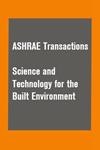Performance evaluation of an auto-cascade refrigeration system using grey correlation theory and response surface methodology
IF 1.6
4区 工程技术
Q3 CONSTRUCTION & BUILDING TECHNOLOGY
Science and Technology for the Built Environment
Pub Date : 2023-04-20
DOI:10.1080/23744731.2023.2203044
引用次数: 0
Abstract
This article focuses on evaluating and analyzing the performance of an autocascade refrigeration system with the zeotropic mixture of R600a/R1150/R14 refrigerants using grey correlation theory and response surface methodology (RSM). The correlation degree among various factors is analyzed using grey correlation theory. The interactive influences that have significant impacts on the six output parameters are illustrated, and a regression model is further validated by five confirmation parameters. The results show that the vapor quality of the evaporator outlet is the greatest factor that affecting the refrigerating capacity and coefficient of performance (COP). However, the evaporation temperature has the greatest effect on compressor’s discharge temperature, pressure ratio, exergy destruction rates, and exergy efficiency. Lower vapor quality of the condenser outlet and condensation temperature can improve the performances of refrigerating capacity, COP, compressor’s discharge temperature, compression ratio, total exergy destruction rate, and exergy efficiency based on the RSM results. The random five groups of validation parameters indicate that the errors between the predicted modeling and calculation results are all less than 5%, demonstrating that the RSM model has good predictability. The results achieved in this work will assist in the optimizing analysis and the application of cryogenic refrigerators.基于灰色关联理论和响应面法的自复叠制冷系统性能评价
本文采用灰色关联理论和响应面法(RSM)对R600a/R1150/R14共沸混合物自升式制冷系统的性能进行了评估和分析。运用灰色关联理论分析了各因素之间的关联度。说明了对六个输出参数有显著影响的交互影响,并通过五个确认参数进一步验证了回归模型。结果表明,蒸发器出口的蒸汽质量是影响制冷量和性能系数的最大因素。然而,蒸发温度对压缩机的排气温度、压力比、火用破坏率和火用效率的影响最大。基于RSM结果,降低冷凝器出口蒸汽质量和冷凝温度可以提高制冷量、COP、压缩机排气温度、压缩比、总火用破坏率和火用效率。随机五组验证参数表明,预测建模与计算结果的误差均小于5%,表明RSM模型具有良好的可预测性。这项工作的结果将有助于低温冰箱的优化分析和应用。
本文章由计算机程序翻译,如有差异,请以英文原文为准。
求助全文
约1分钟内获得全文
求助全文
来源期刊

Science and Technology for the Built Environment
THERMODYNAMICSCONSTRUCTION & BUILDING TECH-CONSTRUCTION & BUILDING TECHNOLOGY
CiteScore
4.30
自引率
5.30%
发文量
78
期刊介绍:
Science and Technology for the Built Environment (formerly HVAC&R Research) is ASHRAE’s archival research publication, offering comprehensive reporting of original research in science and technology related to the stationary and mobile built environment, including indoor environmental quality, thermodynamic and energy system dynamics, materials properties, refrigerants, renewable and traditional energy systems and related processes and concepts, integrated built environmental system design approaches and tools, simulation approaches and algorithms, building enclosure assemblies, and systems for minimizing and regulating space heating and cooling modes. The journal features review articles that critically assess existing literature and point out future research directions.
 求助内容:
求助内容: 应助结果提醒方式:
应助结果提醒方式:


